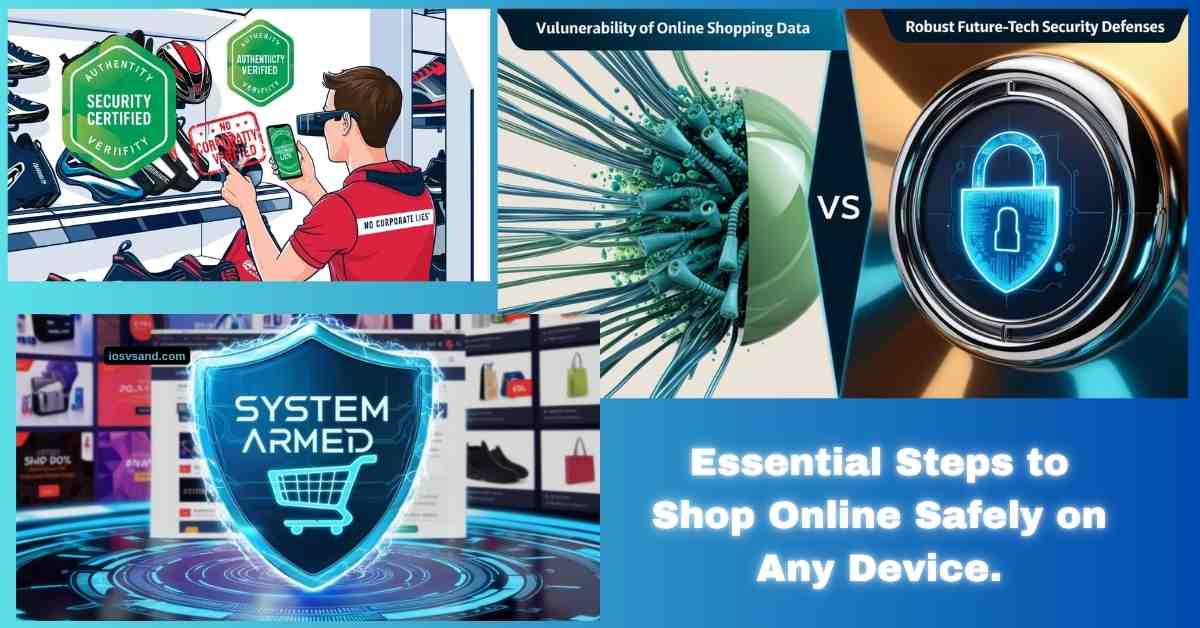Let's be brutally honest: most so-called "smart" home tech is dumber than a bag of…

Incredible Deals, Incredible Safety: Shop Online Safely in 2025
Online shopping delivers packages to your door—and HACKERS to your bank account. Threats now evolve faster than security patches. This guide merges classified reports into ONE ARMORED CHECKLIST:
- HTTPS (the “lock icon” = encrypted connection)
- AI SCAMS (fake “deal alerts” trained on your search history)
- METAVERSE TRAPS (virtual stores stealing real credit cards)
- SESSION HIJACKING (hackers stealing logged-in accounts)
Your 2025 survival rule: TRUST NO POP-UP. Deploy HTTPS VETTING, PRIVACY-FIRST PAYMENTS, and NEVER-CLICK-LINKS discipline. BREACHERS GET NOTHING. Bookmark this. Share it. Burn it into your retina.
- Introduction and Context: The Digital Danger Zone
- Key Points and Emerging Threats: Know Your Enemy
- Technical Security Deep Dive: Under the Hood
- Consumer Behavior and Best Practices: Shop Like a Pro
- Legal Protections and Recourse: Know Your Rights
- Device and Network Security: Lock Down Your Digital Fortress
- Post-Purchase Vigilance: After the Click, Stay Slick
- Case Studies and Real-World Examples: Lessons Learned the Hard Way
- Decoding Guide: Phishing vs. Legit Email Comparison
- The 7 Deadly Sins of Online Shopping: Scam Categories for 2025
- Pre-Purchase Verification Checklist: Before You Click “BUY”
- Decentralized Marketplace Tips: Verifying Smart Contracts
- Practical Tools and Templates: Your Arsenal of Safety
- Expert Insights and Trends: What the Gurus Say
- Final Thoughts: Stay Vigilant, Stay Safe
- FAQs
Introduction and Context: The Digital Danger Zone
ONLINE SHOPPING = FUTURE WARZONE (WITH DISCOUNT CODES)
Digital stores deliver packages and $48 BILLION/YEAR LOSSES (← fraud tsunami). AI SCAM BOTS write better lies than Shakespeare. DEEPFAKE STORES clones real brands pixel-for-pixel. METAVERSE MUGGERS pick virtual pockets for real cash.
WHY CARE?
→ Your savings could evaporate faster than a leaked password.
→ Scammers weaponize AI VOICE CLONES (“Hi, this is your bank!”) and FAKE REVIEWS (5-star lies).
STAT ATTACK (BRACE YOURSELF):
- FTC 2023: $10 BILLION lost → enough to buy 33,333 Lamborghinis 🚗💨
- Zscaler 2024: Phishing up 58.2% → Finance sector hit by 393% SPIKE (← code red!)
- India 2024: 81% checked reviews → 55% STILL got scammed (← trust issues unlocked)
- FTC 2024: $12.5 BILLION fraud → 25% JUMP year-over-year (← crime pays, sadly)
That “too-good” metaverse VR deal? It’s a DEEPFAKE TRAP (← hyper-realistic fake). Arm yourself or become a statistic.
Key Points and Emerging Threats: Know Your Enemy
THE DIGITAL BODYGUARD CHECKLIST
WEBSITE SECURITY = YOUR FIRST SAFETY CHECKPOINT
Check every website URL for HTTPS (the “S” means SECURE encryption). Look for the padlock icon (← your browser’s security bouncer). Search for reviews on Trustpilot or the Better Business Bureau (← crowd-sourced truth serum). Verify the seller’s contact information and physical address (no PO boxes = fewer ghosts). Use WHOIS lookup tools (domain age detectives) → if the site was registered LESS THAN 1 YEAR AGO <– RED FLAG (new domains = pop-up scam shops).
PAYMENT ARMOR: CREDIT CARDS & DIGITAL WALLETS
Use credit cards (chargeback shields let you reverse fraudulent charges) or Apple Pay/Google Pay (tokenization replaces your card number with random gibberish). Avoid gift cards (scammer favorites), cryptocurrency (untraceable = no refunds), and fake “eco-payments” (← greenwashed traps).
DATA LOCKDOWN PROTOCOL
Share LESS personal info (your ZIP code ≠ required for a coffee mug). Use a VPN like NordVPN (← invisibility cloak for public Wi-Fi). Update devices DAILY (security patches = weakness repairs). Install antivirus software like Norton (malware bodyguards).
THE AI TRAP LABYRINTH
DEEPFAKE CONTENT = DIGITAL SHAPE-SHIFTERS
AI now generates fake product reviews (← chatbots impersonating happy customers), customer service chats (← bots mimicking human agents), and hyper-realistic product videos (← CGI lies). Losses from fake videos could hit $40 BILLION BY 2027 → enough to buy 80 million PS5 consoles 🎮.
PHISHING 2.0: SMARTER BAIT
Forget clumsy “Nigerian prince” emails. Now:
→ QR CODE SCAMS (fake codes → malware downloads)
→ SMS SPOOFING (texts impersonating Amazon/Banks → “Urgent account fix!”)
→ 60% SPIKE IN AI-POWERED PHISHING (← algorithms write flawless cons)
SOCIAL MEDIA & METAVERSE MINEFIELDS
Fake influencers (AI-generated “celebrities”) push deepfake product demos (← blender that doesn’t blend). 21% OF SHOPPERS bought counterfeit goods due to these lies. Metaverse risks:
→ NFT FRAUD (fake digital art sales)
→ AVATAR IMPERSONATORS (stealing virtual wallets in Decentraland/Meta Horizon Worlds)
→ VIRTUAL STORE SCAMS (selling nonexistent VR gear)
CORE THREAT: AI scams adapt faster than human instinct. STAY PARANOID.
Technical Security Deep Dive: Under the Hood
THE ENCRYPTION BLACK BOX
HTTPS/SSL: YOUR DATA’S INVISIBLE ARMOR
The padlock icon means the site uses HTTPS (Hypertext Transfer Protocol Secure) → a protocol that encrypts (scrambles) your data. Websites with SSL certificates (Secure Sockets Layer) from companies like DigiCert act like digital bodyguards. 95% of legitimate sites use HTTPS, but fake sites can fake the padlock → never trust it alone.
PAYMENT TECH: TOKENIZATION & BIOMETRICS
Digital wallets (Apple Pay, Google Pay) use tokenization (replacing card numbers with random codes) and biometric authentication (FaceID, fingerprints). Virtual cards (Privacy.com) generate disposable numbers for single purchases →, perfect for dodging fraud.
PASSWORD VAULTS & 2FA: DOUBLE-LOCK DEFENSES
Password managers like 1Password use zero-knowledge encryption (even the company can’t see your passwords). Two-Factor Authentication (2FA) adds a second layer (e.g., codes via Authy) → hackers need BOTH your password and phone.
DEVICE SECURITY: MOBILE vs. DESKTOP BATTLES
→ Mobile risks: Fake apps (app spoofing) mimic legitimate ones → check developer names and permissions.
→ Desktop risks: Malicious browser extensions (e.g., fake ad blockers) → use HTTPS Everywhere (forces secure connections) and uBlock Origin (blocks malicious scripts).
QUANTUM COMPUTING: FUTURE-PROOFING ENCRYPTION
Quantum computers could crack RSA encryption (today’s standard) → researchers are testing quantum-resistant algorithms like NIST’s CRYSTALS-Kyber (new encryption locks for the future).
Consumer Behavior and Best Practices: Shop Like a Pro
THE SCAM-HUNTER’S FIELD MANUAL
PRE-PURCHASE VERIFICATION: YOUR DIGITAL DETECTIVE KIT
→ DOMAIN CHECK: Run a WHOIS lookup (domain age detective tool). 65% of scam sites use domains UNDER 1-YEAR-OLD ← fresh registrations = higher risk.
→ SOCIAL PROOF AUDIT: Perform a reverse-image search (Google Lens = photo truth serum). Stolen product images often expose dropshipping scams (counterfeit goods).
→ RED FLAG ALERTS: Reject pressure tactics (“Only 1 left!”) and weird payment demands (gift cards/crypto = no refunds). TRUST YOUR GUT <– Your instincts have malware detectors.
PAYMENT METHOD RISK ASSESSMENT (BY THE NUMBERS)
| METHOD | SAFETY SCORE | WEAK POINT |
|---|---|---|
| Credit Card | 9/10 | Over-limit penalties |
| PayPal | 6/10 | Phishing-prone accounts |
| Virtual Card | 9/10 | Compatibility issues |
PRE-PURCHASE CHECKLIST (NON-NEGOTIABLE)
✅ Confirm HTTPS padlock (encrypted connection)
✅ Run WHOIS lookup (domain age ≤1 year = caution)
✅ Reverse-image search product photos (expose stolen visuals)
✅ Use credit/virtual cards only (fraud protection forcefield)
Legal Protections and Recourse: Know Your Rights
THE LEGAL ARMORY
GLOBAL CONSUMER RIGHTS (YOUR LEGAL SHIELDS)
→ USA: FTC’s Cooling-Off Rule (cancel eligible purchases within 3 days) + Fair Credit Billing Act (dispute billing errors within 60 days).
→ EU: GDPR (force companies to delete your data) + 14-day return policy (no-questions-asked refunds).
→ India: DPDP Act 2023 (strict data protection → companies must report breaches within 72 hours + $30M fines for breaches).
→ Cross-border traps: Customs fraud (fake import fees) + currency scams (dynamic exchange rate trickery).
DISPUTE PATHWAY (YOUR LEGAL SWORD)
- Contact the seller (document everything).
- Escalate to your bank (chargeback requests).
- Regulatory cavalry:
- USA: FTC (file at https://ReportFraud.ftc.gov) / IC3 (for cybercrimes). https://www.ic3.gov/
- EU: Online Dispute Resolution (ODR) portal (cross-border dispute mediator). https://ec.europa.eu/consumers/odr/
- India: Consumer Protection E-commerce Rules, 2020 (report at https://consumerhelpline.gov.in/public/).
- Download fraud report templates (pre-written email scripts → streamline reporting).
Device and Network Security: Lock Down Your Digital Fortress
THE DIGITAL FORTRESS CONSTRUCTION KIT
PUBLIC WI-FI = LANDMINES
Avoid “Evil Twin” hotspots (fake networks mimicking coffee shop Wi-Fi) → ALWAYS deploy a VPN (NordVPN/ExpressVPN = encryption tunnels).
ANTIVIRUS: YOUR MALWARE BODYGUARD
Install Kaspersky or Malwarebytes (real-time threat detection → blocks ransomware/keyloggers).
BROWSER EXTENSIONS: AD-BLOCKING ARMOR
Add AdGuard AdBlocker (← kills malicious ads + trackers) → stops “drive-by downloads” (auto-installed malware).
MOBILE DEFENSE PROTOCOL
→ Disable “Auto-Join Wi-Fi” (prevents accidental Evil Twin connections)
→ Audit app permissions (why does a weather app need your contacts?) → Mobile fraud stems from overprivileged apps.
Post-Purchase Vigilance: After the Click, Stay Slick
THE POST-PURCHASE SENTRY
MONITORING: YOUR DIGITAL TRIPWIRES
Use Credit Karma (free credit score alerts) + Aura (dark web surveillance → scans for leaked card numbers). Check accounts DAILY → Most fraud occurs within a few hours of purchase.
DELIVERY SCAMS: FAKE TRACKING TACTICS
Ignore texts claiming to be USPS/FedEx (“Reschedule delivery!” ← phishing links). Verify shipments ONLY through official apps/websites like Aliexpress, appsumo, Amazon, etc. A large number of delivery scams start with SMS spoofing.
RETURN FRAUD: BAIT-AND-SWITCH TRAPS
Screenshot return policies before buying → Shady sellers alter terms post-purchase. Watch for “restocking fees” or “final sale” edits you didn’t approve.
POST-PURCHASE CHECKLIST (YOUR SAFETY RITUAL)
✅ Weekly credit statement audits (hunt for micro-charges)
✅ Track deliveries via carrier apps (never click SMS links)
✅ Archive return policy snapshots (timestamped evidence)
Case Studies and Real-World Examples: Lessons Learned the Hard Way
THE SCAMMER PLAYBOOK ARCHIVE
(Real-World Clusterf— [Disasters] Decoded for Your Protection)
☠️ TEMU (2023):
DATA VAMPIRISM – Hidden trackers + alleged malware led to 87 MILLION RECORDS spilled. <– Your address? Their profit center.
LESSON: Free isn’t free when your privacy is the currency.
🛑 TIKTOK SHOP (2024):
FAKE AIRPODS GALORE – “Luxury deals” = counterfeit earbuds with the audio quality of a tin can. <– Scammers 1, Your Wallet 0.
LESSON: If the price seems SUS, it’s probably BUST.
💀 CLONED STORES (Shopify Doppelgängers):
PHANTOM PRODUCTS – Sites mimicked real brands, took payments, then poof – no tracking, no refunds. <– Digital shoplifting at scale.
LESSON: Verify URLs like you’re defusing a bomb. One typo = BOOM.
INSTAGRAM LUXURY TRAPS (2023-24):
GUCCI? MORE LIKE FUCCI – Fake designer bags flooded DMs. <– Flexing scams just got aesthetic.
LESSON: Influencer ≠ Inspector. Trust labels, not filters.
🌐 METAVERSE NFT RUG PULLS (2024-25):
DECENTRALAND DISASTERS – Fake avatars sold “rare” NFTs that vanished faster than a Snapchat message. <– Virtual assets, actual bankruptcy.
LESSON: Blockchain ≠ Bull****-proof. DYOR (Decode Your Own Risks).
💰 CRYPTO CAUTIONARY TALES:
₿ EMINIFX (2022): $260M stolen via “guaranteed returns” targeting Haitian immigrants. <– Ponzi schemes don’t care about borders.
₿ ELON MUSK IMPERSONATORS (2025): Fake celeb accounts pushing vaporware crypto. <– Musk isn’t sliding into your DMs. Ever.
✅ SUCCESS STORIES (YES, THEY EXIST):
- CONNECTICUT (2024): $180K recovered via chargeback artillery.
- ONTARIO (2022): Police traced Bitcoin → $55K returned.
- LESSON: Act FAST. Screenshot EVERYTHING. Be the Karen banks fear.
FINAL BOSS ADVICE: Assume every click is a trap. Verify like a CIA analyst.
BOTTOM LINE: These aren’t “stories“ – they’re YOUR FUTURE SCENARIOS if you skip due diligence. Stay paranoid, stay protected.
Decoding Guide: Phishing vs. Legit Email Comparison
THE INBOX BODYGUARD MANUAL
SENDER ADDRESS: DOMAIN SANITY CHECK
Legit: [email protected] (@paypal.com = verified sender)
Phishing: [email protected] (unaffiliated domain = imposter)
GREETING: RECOGNITION vs. RANDOM
Legit: “Hi [First Name], your order is confirmed” (system-generated accuracy)
Phishing: “Dear account holder” (zero identity verification = shotgun approach)
LINKS: HYPERLINK BIOHAZARD
Legit: “View Receipt” → https://www.amazon.com/gp/css/history (logical path)
Phishing: “Confirm Identity” → http://amazon-id.securevalidation.top (http + typos = danger)
TONE: ROUTINE vs. RAGEBAIT
Legit: “Your payment to Spotify was successful” (expected transaction)
Phishing: “CRITICAL ALERT: Unauthorized access detected! ACT NOW!” (manufactured crisis)
DESIGN: QUALITY CONTROL AUDIT
Legit: Consistent branding, mobile-responsive design, no typos
Phishing: Broken formatting on mobile, “Amaz0n Support Team” (zero capitalization = sloppy)
SIDE-BY-SIDE COMBAT
✅ Legit: e.g. “Hi Michael, your Amazon delivery arrives tomorrow. Track at amazon.com/track.”
❌ Phishing: e.g. “ACCOUNT LOCKED! Verify at amaz0n-verification.cc to avoid termination!”
PRO TIPS:
- Use email providers with AI phishing filters (e.g., Gmail Advanced Protection). Phishing attacks increasingly use homograph attacks (replacing “o” with “0”).
- Do you suspect an email? MANUALLY TYPE amazon.com → never click embedded links. Phishing scams impersonate delivery notices.
- Right-click + copy the link to the text editor → expose masked URLs. Phishing often uses .xyz/.online domains for fake portals.
FINAL WARNING: Phishing evolves daily. SLOW DOWN + SCRUTINIZE → SAVE YOUR FINANCES.
The 7 Deadly Sins of Online Shopping: Scam Categories for 2025
Forget playing whack-a-mole with individual scams. We’ve cracked the code and condensed ALL the main online shopping nastiness of 2025 into just SEVEN core categories. Think of this as your cheat sheet for the digital underworld. Each category breaks down how these cyber-creeps operate and the tell-tale signs to watch for. Stay sharp, folks!
Spotting the Scams: Your Cheat Sheet for 2025
| Scam Category | Operation Details | Detection Clues (What You Should Do) |
|---|---|---|
| Impersonation Scams 🎭 | Scammers pretend to be people or groups you trust using fake calls, emails (phishing), and AI voice/text. They impersonate banks, governments, tech companies, or brands to steal data or install malware. | Be suspicious of unexpected or general messages. Don’t panic if they say your account is suspended or your device is infected. Verify the sender’s details carefully. Never give personal data (SSN, logins) or remote access unless you initiate the contact. |
| Gift Card Scams 🎁 | Fraudsters sell fake gift cards, use fake balance checkers, steal funds, or resell used/expired cards as new. | Avoid paying exclusively with gift cards. Be wary of pop-up offers or unofficial websites for gift cards—question suspiciously low prices. Check the PIN area for scratches and the balance before buying. |
| Website Scams 🌐 | Fake websites (clone sites, counterfeit storefronts, mirror pages) with deep discounts steal credit card data and never deliver. | Be cautious of prices that seem too low. Look for bad English, misspelled URLs, or inconsistent design. Check for physical contact details and a working “About Us” page. Ensure the website uses HTTPS and has verified product reviews. Use a WHOIS lookup to check the domain age. |
| Social Media Scams 📱 | Scammers use hacked accounts, fake influencers, and AI profiles to promote fake deals, giveaways, and celebrity endorsements, pressuring users for immediate payments or data. | Be skeptical of flash sales or limited-time offers in direct messages. Check account follower counts and post history for inconsistencies. Verify celebrity endorsements independently. Never share personal info in public comments or DMs. |
| Job Offer Scams 💼 | Fraudsters offer fake remote jobs with high salaries, demanding upfront fees for “equipment” or “training.” They use text-only interviews or fake portals to collect IDs and bank details. | Question unrealistic salary claims and vague company details. Never pay upfront fees for equipment or training. Insist on video interviews. Be cautious of requests for sensitive documents like passport scans or bank details early in the process. |
| Card/Payment Scams 💳 | Scams cause fake declined transactions or use fake checkout pages to steal card data. Tactics include fake errors, malware/keyloggers, and fraudulent recurring charges. | Be wary of multiple “declined” alerts on valid cards. Monitor your accounts for unexpected charges. Ensure checkout pages are secure (HTTPS and padlock). Pay attention to browser warnings about security certificates and avoid redirects to unknown websites. Use strong antivirus software. |
| Deepfake/AI Scams 🤖 | Scammers use advanced AI to create fake videos (deepfakes), voice copies, and personalized fake emails (phishing), impersonating trusted contacts to authorize fake payments. | Watch for robotic speech, lip-sync errors or video glitches. Be cautious of generic greetings when handling unexpected requests. Listen for ambient background noise in voice messages. Double-check sender email domains for slight misspellings. Verify unusual requests through official channels or by contacting the person directly through a known, trusted method. Be suspicious of requests that bypass routine procedures. |
BOOKMARK THIS CHEATSHEET → Cross-reference before ANY online transaction.
Pre-Purchase Verification Checklist: Before You Click “BUY”
YOUR PRE-PURCHASE SCAN PROTOCOL
1. WEBSITE SECURITY AUTOPSY
Check for HTTPS:// + padlock icon → click it. Legit sites show “Connection Secure” with valid certificates from DigiCert/Let’s Encrypt. Expired cert? → INSTANT ABORT.
2. DOMAIN AGE FORENSICS
Mentally run WHOIS lookup (domain birth records). Sites <1 YEAR OLD have a higher scam risk. 5+ year domains = lower threat.
3. IMAGE ORIGIN TRACING
Right-click product photo → reverse-image search (Google Lens). Matches found on AliExpress/10+ sites? → dropshipping scam.
4. REVIEW AUTHENTICITY SCAN
Hunt for AI-generated patterns:
→ Identical phrasing (“Life-changing product!”)
→ No specific details (“Works great!” vs. “Battery lasts 8hrs”)
→ Stock photo profile pics
5. CONTACT INFO STRESS TEST
Call listed numbers → deadlines/bots? RED FLAG. Verify physical address via Google Maps → empty warehouses = scam HQ.
6. PAYMENT METHOD INTERROGATION
Block demands for gift cards/crypto/wire transfers. Use credit cards (chargeback shields) or Privacy.com virtual cards. Check PayPal URLs → paypal.com ≠ paypa1.com.
REAL-WORLD EXAMPLE: VR HEADSET TRAP
Site: *******scam.com
✅ Padlock present
❌ Registered 89 DAYS AGO
❌ Product photo matches AliExpress listing
❌ Reviews: “10/10!!!” with duplicate timestamps
❌ Contact: “Suite 5B” = virtual office
❌ Demands Bitcoin payment
DIAGNOSIS: MALICIOUS OPERATION → NUKE FROM ORBIT.
TEST CASE:
Even if the site passes Layers 1 and 6 but fails 2,3,4 → CANCEL PURCHASE.
Decentralized Marketplace Tips: Verifying Smart Contracts
THE SMART CONTRACT SURVIVAL KIT
BLOCKCHAIN SHOPPING = CODE WARFARE
Smart contracts (self-executing deal terms) control transactions on platforms like OpenSea 2.0 or Decentraland. Scammers rewrite code to steal crypto → $millions vanished in Decentraland heists.
YOUR VERIFICATION TOOLBELT
- CODE LITERACY: Treat contracts like recipe cards → “Send 0.1 ETH, receive NFT” = fair. “Send ETH, get nothing” = scam. Use Etherscan (blockchain microscope) to read contract logic.
- SELLER BACKGROUND CHECK: Wallet IDs (0x1234…) reveal history. 50+ sales + positive feedback = green light. New wallet + zero activity = red flag.
- AUDIT OR BUST: Legit projects display CertiK/Trail of Bits audit badges (code health certificates). No audit mentions = ⇑ scam risk.
- MICRO-TRANSACTION TEST: Send 0.01 ETH first →; confirms contract works. Lose pennies, not life savings.
- WALLET PERMISSION LOCKDOWN: Reject “unlimited spending” approvals. Only authorize exact purchase amounts (e.g., 0.1 ETH).
RED FLAG ALERTS
→ “Limited NFT drops“ with no Discord/Telegram hype
→ Contracts with hidden withdrawal functions (auto-drains your wallet)
CASE STUDY: META-SNEAKER NFT vs. VR LAND SCAM
✅ MetaSneaker: 50 sales history + CertiK audit badge + 0.01 ETH test success → SAFE
❌ VR Land Plot: New seller + no audits + demands 1 ETH upfront → MALICIOUS CODE
BONUS MOVE: Visit Metaverse storefronts → glitchy avatars/empty lots = digital ghost towns.
Practical Tools and Templates: Your Arsenal of Safety
THE DIGITAL ARMORY
PRE-PURCHASE CHECKLISTS = YOUR WEAPONIZED TO-DO LISTS
Check WHOIS verification guides (domain background checks), HTTPS inspection templates (padlock audits), and reverse-image search workflows (product photo forensics).
VISUAL GUIDES = PHISHING X-RAY GOGGLES
Study NCA Toolkit → train your brain to spot fake sender addresses + typo-riddled URLs in milliseconds.
FRAUD REPORTING TEMPLATES = PRE-WRITTEN JUSTICE
Plug-and-play email scripts for FTC, IC3, and local authorities → slash reporting time by 70%.
VPN SETUP MANUALS = WI-FI BODYARMOR
Step-by-step guides for NordVPN/ExpressVPN installation → encrypt connections in 3 clicks (yes, even for technophobes).
DECENTRALIZED SAFETY TOOLS = CRYPTO SHIELDS
Master Etherscan smart contract verification → decode blockchain deals like a pro (no coding degree required).
Expert Insights and Trends: What the Gurus Say
THE CONSUMER SHIELD MANIFESTO
(2025 Threat Landscape Decoded by Industry Spartans)
THREAT ALPHA → AI-GENERATED FAKE STORES
- SOURCE: Which? cybersecurity analysts
- TACTIC: Scammers use generative AI to clone legit retailer sites → fake deals.
- WHY IT MATTERS: These sites look REALER THAN REAL → your eyeballs can’t tell the difference.
- USER ACTION: Manually verify URLs → avoid “Amaz0n-deals.net”.
THREAT BRAVO → VOICE CLONING SCAMS
- SOURCE: Experian fraud division
- TACTIC: Scammers clone voices from social media →, impersonate your mom/boss, → trick you into approving fake payments.
- WHY IT MATTERS: Your ears = new weak spot. Trust NO VOICE without verification.
- USER ACTION: Hang up → call back via a known official number.
THREAT CHARLIE → SOCIAL MEDIA AD FRAUD
- SOURCE: Better Business Bureau (BBB)
- TACTIC: Fake TikTok/Instagram ads for “viral” products → redirect to scam sites.
- WHY IT MATTERS: Social platforms = minefields of manufactured FOMO.
- USER ACTION: Never click “limited-time offer” links in Stories.
THREAT DELTA → DELIVERY SCAM 2.0
- SOURCE: Recorded Future threat hunters
- TACTIC: Send fake “package held” alerts or mystery boxes → demand payment for phantom orders.
- WHY IT MATTERS: Shipping anxiety = scammer’s best friend.
- USER ACTION: Track packages ONLY via carrier apps (UPS/FedEx) → ignore unsolicited texts.
THREAT ECHO → SYNTHETIC IDENTITY FRAUD
- SOURCE: Mitek Systems
- TACTIC: AI-forged IDs make purchases → you get blamed for debts.
- WHY IT MATTERS: Your credit score = collateral damage.
- USER ACTION: Freeze credit reports if unusual activity is detected.
COUNTERMEASURE → REGULATORY CRACKDOWN
- SOURCE: Pangaea X
- ACTION: Platforms must deploy AI fraud detectors → reduce scam success rates.
- WHY IT MATTERS: Governments are finally treating scams like digital terrorism.
- USER ACTION: Report suspicious sites to the official Government complaint websites → leverage new laws.
HUMAN FACTOR → ECONOMIC DESPERATION
- SOURCE: Mintel
- FINDING: Bargain hunters ignore red flags → huge increase in “too good” deal traps.
- WHY IT MATTERS: Fear of inflation > fear of fraud.
- USER ACTION: Use price-tracking tools → verify if “discounts” are real.
INSIDER THREATS → SOCIAL MEDIA RECRUITMENT
- SOURCE: Mitek financial crime team
- TACTIC: Criminals recruit store employees via LinkedIn/Discord → enable fraudulent transactions.
- WHY IT MATTERS: Your data’s safety depends on minimum-wage workers’ ethics.
- USER ACTION: Report suspicious employee behavior anonymously.
BOTTOM LINE: Experts agree – 2025 scams are smarter, louder, and personal. Your defense? Paranoid-level verification.
Final Thoughts: Stay Vigilant, Stay Safe
THE DIGITAL SURVIVALIST’S MANIFESTO
KNOWLEDGE = YOUR ULTIMATE ANTIVIRUS
Scammers evolve faster than ever, but your brain holds the FIREWALL CODE. Master HTTPS checks, AI scam patterns, and chargeback rights → turn yourself into a HUMAN CAPTCHA against fraud.
2025’s RULEBOOK:
→ VERIFY like a paranoid spy (domains, SSL certs, seller IDs)
→ VIGILANCE on steroids (spot deepfakes, phishing hooks, fake reviews)
→ SECURE PAYMENTS or bust (credit cards > crypto, virtual cards > reckless trust)
Bookmark this guide. Revisit it quarterly. THE JUNGLE GETS WILDER EVERY DAY.
FAQs
5 immutable shopping laws?
HTTPS:// (the “S” is your force field)
Home network bunkers ONLY (public Wi-Fi = enemy territory)
Credit cards = armored trucks (debit = wheelbarrows)
Pop-up/ad blockers (malware mosquito nets)
Grammar SWAT mode (scammers fail language arts)
How do I armor-plate my online shopping?
Treat every click like a bank vault breach drill. Bookmark this guide’s checklists (HTTPS, padlocks, reverse-image searches) → transform yourself into a human firewall.
Debit cards = signing a blank check?
Debit = direct debit to disaster (zero fraud buffers). Credit cards = bulletproof vests → banks fight chargeback battles FOR you.



